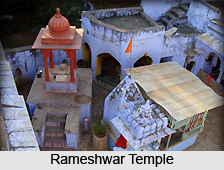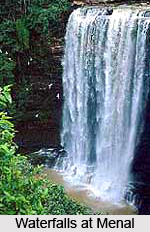 The kingdom of Bundi is surrounded by picturesque places. While some of these sites are of religious importance the others are for their citadels and even magnificent resorts. Local transportations and cars on hire are available for the making a trip to the places of interest around Bundi.
The kingdom of Bundi is surrounded by picturesque places. While some of these sites are of religious importance the others are for their citadels and even magnificent resorts. Local transportations and cars on hire are available for the making a trip to the places of interest around Bundi.
Rameshwar Temple is located 20 kilometers away from Bundi. It is dedicated to Lord Shiva. It is a picturesque site having a waterfall with a tank below. It lies quite close to the Ratna Sagar Lake. The beauty of this place is indescribable. A small fort and the Dhuleshwar Mahadev Temple and a picturesque waterfall nearby to it are the added attractions. This region is also famous for its craftsmanship, especially, pottery.
Gararda is a village that is located 32 kilometers away from Bundi. Exquisite rock paintings have been found on rocks flanking the river. It is believed that these paintings depicting animals, hunting scenes, armies, human figures, episodes from daily life and dancing postures are 15,000 years old.
35 km northeast of Bundi, Dugari, is home to migratory birds in the lovely lake, Kanak Sagar. Here the walls depict the raas-lila of Radha-Krishna.
77 kilometers away from Bundi the tourists will come across Indragarh. It was founded by Indrasal Singh Hada in the 17th century. The temples of Goddess Kali and Kamleshwar are worth checking out. The walls of the palace within the fort are ornamented with typical Bundi style paintings.
 Bijolia is located at a distance of 50 kilometers from Bundi. This town has a fortress and ruins of 11th century temples. The 13th century Undeshwara Temple and its sanctorum have a half submerged Shiva ling. This is the most remarkable local attraction here. The entire temple has been built in the Hindu architectural style. it has pagoda covered with bands of beautifully carved stone motifs. Nearby is an old Ganesh temple with a very fine image. There are also ruins of some other old temples dating back between 11th to 13th centuries.
Bijolia is located at a distance of 50 kilometers from Bundi. This town has a fortress and ruins of 11th century temples. The 13th century Undeshwara Temple and its sanctorum have a half submerged Shiva ling. This is the most remarkable local attraction here. The entire temple has been built in the Hindu architectural style. it has pagoda covered with bands of beautifully carved stone motifs. Nearby is an old Ganesh temple with a very fine image. There are also ruins of some other old temples dating back between 11th to 13th centuries.
Umaid Bagh Resort was the royal rest house Shreeji Umaid Singh ji, ruler of the Bundi state in the 18th century. Presently this magnificent building has been converted to a heritage hotel. The striking feature of this resort is that it is surrounded by water from three sides. The exotic bird life including migratory and Indian birds and the outdoor activities like trekking and jeep safari in an adjoining countryside make the stay memorable.
Menal is well known for its waterfalls. The waterfall thus formed particularly in the monsoon attracts a lot of people from the nearby towns. It is located 20 kilometers ahead of Bijolia on the Bundi-Chittorgarh road. This place houses many ancient temples that date back to the Gupta period. The old temple complex has an imposing Shiva temple entered through a gateway carved with images of Bhairava and Ganesh. The temples walls are carved with idols of Lord Shiva and Parvati in various forms, animals, dancers and musicians.
Another palace ruin belonging to the 20th century is said to be the mountain retreat of the legendary Rajput Prithviraj Chauhan. Other noteworthy sites are Hajashwar Temple and Mahakaleshwar Temple.



















